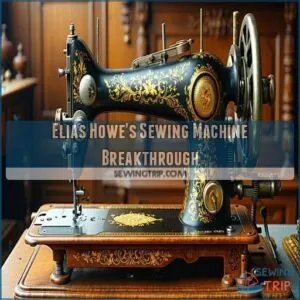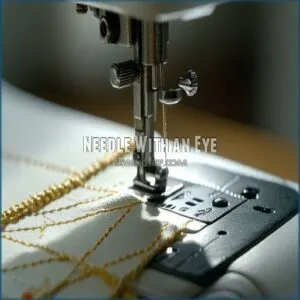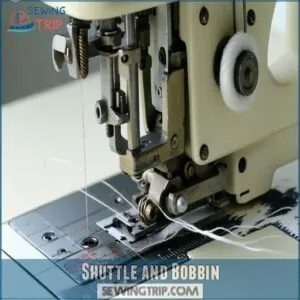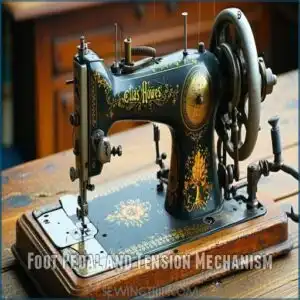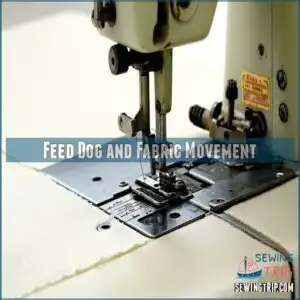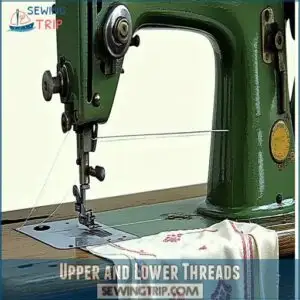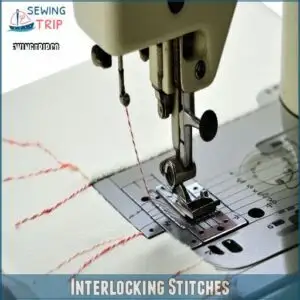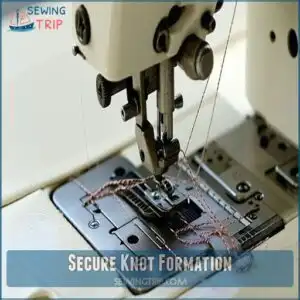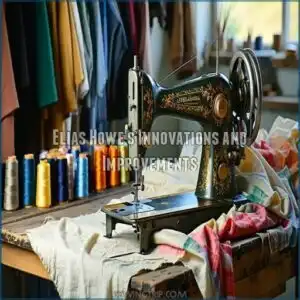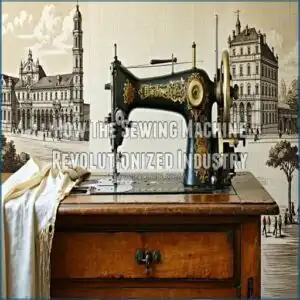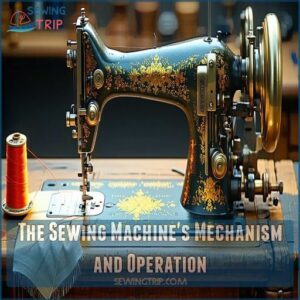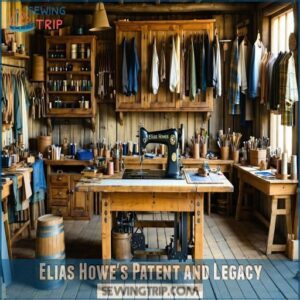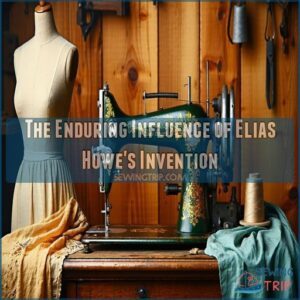This site is supported by our readers. We may earn a commission, at no cost to you, if you purchase through links.
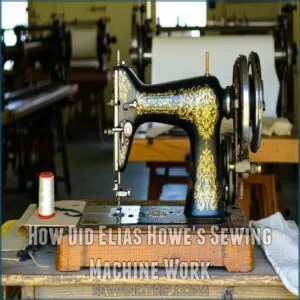
The needle pierced the fabric, pulling the upper thread through to meet the thread from the shuttle below. These threads interlocked to form a secure and durable stitch.
Powered by a foot pedal, or treadle, the machine kept the fabric moving smoothly with the help of feed dogs underneath. This system made sewing faster and far less tedious.
Howe’s invention wasn’t just clever—it set the stage for the mass production of clothing you see today, using a mass production technique.
Table Of Contents
- Key Takeaways
- Elias Howe’s Sewing Machine Breakthrough
- How Did Elias Howe’s Sewing Machine Work
- Key Components of The Sewing Machine
- The Lockstitch Mechanism Explained
- Elias Howe’s Innovations and Improvements
- How The Sewing Machine Revolutionized Industry
- The Impact on Fashion and Society
- The Sewing Machine’s Mechanism and Operation
- Elias Howe’s Patent and Legacy
- The Enduring Influence of Elias Howe’s Invention
- Frequently Asked Questions (FAQs)
- Conclusion
Key Takeaways
- You’ll see how Elias Howe’s sewing machine used a lockstitch mechanism with a needle and shuttle to interlock two threads, creating strong and consistent stitches.
- It worked by moving the fabric smoothly underneath with feed dogs while precise thread tension ensured uniform stitching.
- The foot pedal powered the machine’s motion, letting you sew faster and more efficiently compared to hand sewing.
- Howe’s invention revolutionized garment production by enabling mass production, reducing costs, and making clothing more accessible.
Elias Howe’s Sewing Machine Breakthrough
You’ll discover how Elias Howe’s revolutionary sewing machine, patented in 1846, used a unique lockstitch method.
This ingenious mechanism, featuring a curved needle and a shuttle, forever changed clothing production.
It paved the way for modern sewing technology.
Early Life and Inspiration
Elias Howe Jr.’s journey began in 1819 in Spencer, Massachusetts. His family background in farming shaped his early life. Howe’s early motivations stemmed from observing his wife’s laborious hand-sewing. These life events set the stage for Elias Howe’s biography and his groundbreaking invention, the Elias Howe sewing machine.
At 16, he ventured into Lowell’s machine shops, marking his career beginnings.
- Born in Spencer, Massachusetts.
- Apprenticed in Lowell’s machine shops.
- Inspired by his wife’s sewing struggles.
- Received $500 investment from George Fisher.
Development of The Sewing Machine
Driven by his wife’s tireless hand-sewing, Elias Howe began developing his sewing machine in 1844. He carefully refined the Howe sewing machine design, achieving a functional steel model by April 1845.
This marked a pivotal moment in sewing innovations and early sewing machine mechanics. The sewing machine invention had a lasting impact on the industry, transforming the way clothes were made and paving the way for future innovations.
| Year | Milestone | Focus |
|---|---|---|
| 1844 | Project Start | Machine Design |
| 1845 | Steel Model | Sewing Innovations |
| 1845 | Two Suits Sewn | Fabric Handling |
| 1846 | Patent Secured | Thread Technology |
| 1849 | Production Begins | Manufacturing Process |
How Did Elias Howe’s Sewing Machine Work
Howe’s sewing machine’s mechanical operation revolutionized stitching. His lockstitch sewing machine workings used two threads—one passed through the eye of the needle, the other from a bobbin within a shuttle. This formed the lockstitch, a key aspect of the Howe sewing machine design. The innovative lockstitch mechanism guaranteed durable stitch formation.
The industrial revolution impact was significant due to this invention.
- Precise thread tension created uniform stitches.
- The fabric feed moved the material smoothly under the needle.
- The needle created a loop, catching the lower thread.
- The shuttle tightened the threads, forming the lockstitch. This sewing machine mechanical operation was groundbreaking.
Key Components of The Sewing Machine
You’ll now explore the ingenious components that made Howe’s sewing machine a groundbreaking invention.
These parts, working together in harmony, enabled the machine to create strong, consistent stitches, transforming the textile industry.
Needle With an Eye
So, how did Howe’s ingenious lockstitch mechanism actually work? It all starts with the needle. A key innovation in the Elias Howe sewing machine was the needle’s eye, positioned near the point. This seemingly simple Needle Design facilitated the Sewing Action and precise Eyelet Formation, a departure from earlier machines.
This unique placement allowed the thread to pass through fabric smoothly, minimizing tangles and improving Thread Tension control for various Stitch Patterns. The needle design principles developed by Elias Howe have become fundamental to modern sewing machines.
| Feature | Purpose | Impact |
|---|---|---|
| Eye Location | Thread Control | Reduced Snags |
| Sharp Point | Fabric Pierce | Clean Holes |
| Steel Construction | Durability | Long Life |
| Groove Design | Thread Guide | Even Stitches |
Shuttle and Bobbin
From the eye of the needle, we move to the heart of the lockstitch mechanism: the shuttle and bobbin. This dynamic duo works beneath the fabric.
The shuttle, carrying the bobbin thread, swiftly catches the needle’s loop. This interaction forms the lockstitch, managed by precise thread tension.
The sewing machine shuttle plays a key role in the overall functionality. Bobbin winding guarantees a continuous yarn flow, while shuttle speed dictates stitch formation.
This clever sewing machine mechanism revolutionized how we sew.
Foot Pedal and Tension Mechanism
Howe’s foot pedal powered the sewing machine mechanism, driving the needle’s vertical motion. The foot mechanism’s speed regulation further influenced stitch length. The sewing machine foot pedal played a vital role in the overall functioning of the sewing machine. Pedal control dictated needle speed. Speed regulation allowed for varied stitch lengths.
Simultaneously, the tension mechanism, often a spring-loaded disc, regulated thread tension. This precise tension adjustment prevented tangling and guaranteed consistent lockstitch formation. * Tension adjustment fine-tuned thread flow. The shuttle and bobbin interacted with the needle and thread tension to create the lockstitch.
- Foot mechanism powered the entire system.
Feed Dog and Fabric Movement
Elias Howe’s sewing machine mechanism included a key innovation: the feed dog. These small metal dog teeth grip the fabric from below, regulating fabric movement as you sew.
Synchronized with the lockstitch mechanism, the feed dogs advance the material at consistent feed rates for each stitch. This precise material guidance eliminates the need for manual adjustments, assuring stitch regulation and even fabric tension.
A simple lever allows you to drop the feed dogs for free-motion sewing.
The Lockstitch Mechanism Explained
Prepare to understand the ingenuity of Howe’s lockstitch mechanism, a key element of his groundbreaking sewing machine.
You’ll see how two threads intertwine to create a durable and efficient stitch, revolutionizing the way we sew.
Upper and Lower Threads
The lockstitch mechanism depends on two threads: the upper thread, supplied from a top spool, and the lower thread, wound on a bobbin below.
These threads interact with the fabric to create the stitch formation. Proper thread tension is crucial for a balanced stitch.
This ensures the upper and lower threads interlock correctly within the fabric layers, forming the foundation of Howe’s sewing machine’s success. This thread choreography is fundamental.
Interlocking Stitches
Two interlocking stitches are formed as the upper thread loops through the fabric. The shuttle then carries the lower thread through this loop, creating the lockstitch. This stitch formation is highly secure due to the thread tension and precise stitch coordination.
Notice how:
- The needle movement creates the initial loop.
- The rotating shuttle interlocks the threads.
- The lock stitch secures the fabric weave, regardless of sewing speed.
Secure Knot Formation
Those interlocking stitches create a secure knot formation, the core of the lockstitch’s strength.
As the needle thread loops around the bobbin thread, a knot forms within the fabric layers, binding them tightly. This knot integrity guarantees stitch strength and sewing accuracy, far superior to chain stitches prone to unraveling.
Mastering sewing knot techniques is essential for achieving professional finishes in various sewing projects.
| Feature | Benefit |
|---|---|
| Thread Tension | Ideal knot tightness |
| Fabric Binding | Secure, durable seam |
| Stitch Strength | Resists unraveling |
Elias Howe’s Innovations and Improvements
You’ll notice Elias Howe didn’t stop at creating the first practical sewing machine—he tirelessly worked to make it better.
By improving stitch quality and tackling early design issues, he laid the foundation for a more reliable and efficient tool.
Overcoming Early Challenges
Elias Howe’s sewing machine journey faced steep challenges. Lack of funds nearly derailed his invention, forcing him to sell belongings and search for investors. Competitors copied his lockstitch mechanism, leading to resource-draining patent lawsuits. Market rejection grew from fears it would replace jobs.
Yet, persistent efforts to improve early sewing machine technology slowly changed skeptical public perception, laying the foundation for modern designs.
- Financial struggles overwhelmed progress.
- Competitors hindered investor confidence.
- Skepticism surrounded Elias Howe inventions.
- Repeated technical hurdles plagued designs.
Enhancing Stitch Quality and Durability
Stitch quality and durability improved drastically with Howe’s clever sewing machine features.
The needle design, with an eye near the point, allowed smooth thread flow, essential for the lockstitch mechanism.
Thread tension control maintained reliable stitch density across different fabrics.
The shuttle mechanism maintained steady bobbin pressure, making stitches strong and long-lasting.
- Key advances:
-Precision-engineered needle for efficient sewing operation
-Adjustable tension for consistent stitch quality
-Durable lockstitch formation across various fabric types
How The Sewing Machine Revolutionized Industry
You mightn’t realize it, but sewing machines completely changed how industries worked by making clothing production faster and more efficient.
They turned handcrafted processes into mass production, reshaping the textile and fashion industries forever.
Mass Production and Efficiency
The sewing machine sparked industrial-scale garment production, transforming factory output like never before.
With sewing machine efficiency, production speed soared—40 stitches per minute by hand jumped to 900 via machine.
A shirt once taking 14 hours now took just 1 hour.
Costs dropped from $1.20 to $0.15 per item, delivering unmatched efficiency gains for mass production powered by the lockstitch mechanism.
Impact on Textile and Clothing Industries
Mechanical stitching flipped the textile industry on its head, driving incredible textile growth and reshaping clothing trends. Factories embraced industrial-scale garment production, revolutionizing efficiency and lowering costs.
- Production costs plummeted by up to 80%, making fashion accessible.
- Mass production boomed, turning out thousands of pieces daily.
- Automation disrupted industries, streamlining garment production processes.
From military uniforms to household linens, the sewing machine impact sparked an era of fashion evolution and industry disruption, forever altering the textile landscape.
Rise of Ready-to-Wear Fashion
Before sewing machines, garments were time-consuming and expensive to produce.
Howe’s invention flipped this completely.
Factories embraced industrial-scale garment production, turning out hundreds of identical pieces daily.
Clothing shifted from luxury to accessibility, spawning the ready-to-wear fashion revolution.
Suddenly, style evolution became part of everyday life as fashion trends spread rapidly through the mass market.
Here’s how the sewing machine impacted fashion:
| Aspect | Before Sewing Machines | After Sewing Machines | Sewing Machine Impact Fashion |
|---|---|---|---|
| Cost | High | Affordable | Wider market access |
| Production Time | Weeks | Minutes | Mass production achievable |
| Availability | Limited | Abundant | Made clothing universal |
| Styles | Custom | Standardized | Accelerated trend adoption |
The Impact on Fashion and Society
Elias Howe’s sewing machine transformed the way society viewed clothing by making it more affordable and accessible to everyone.
You could finally own more than just a few hand-sewn garments, changing fashion and even social class dynamics.
Increased Clothing Ownership and Accessibility
Elias Howe’s sewing machine transformed wardrobes and lives, making clothing affordability a reality. Before its invention, garments were expensive and limited.
With the industrial-scale garment production powered by the lockstitch mechanism, clothes became accessible to all. Fashion trends became more inclusive, allowing middle-class families to own more than just a few outfits.
Here’s how the sewing machine improved social impact and consumer benefits:
- Wardrobes grew from a handful of outfits to varied collections.
- Ready-to-wear clothing made high-quality garments available in stores.
- Garment production costs dropped, improving overall garment quality.
- Home sewing flourished, offering a sense of empowerment and creativity.
- Middle-class households enjoyed the practical and stylish benefits of fashion accessibility.
Changing The Way Clothes Were Made
Howe’s sewing machine flipped garment production on its head.
What once took days now happened in hours, thanks to textile innovation and precision-enabled sewing machine mechanisms.
The lockstitch guaranteed consistent, high-quality stitching, while standardized sizing simplified the manufacturing process.
Intricate patterns, impossible by hand, became commonplace.
This leap in sewing machine operation reshaped fashion trends, ensuring clothing accessibility at an entirely new scale.
Rise of The Middle Class and Domesticity
Affordable sewing machines reshaped households, merging traditional values with modern convenience. For middle-class families, owning one symbolized progress and economic growth. Women embraced home sewing, balancing creativity and practicality.
- Social Change: Domestic labor adapted, blending efficiency with self-expression.
- Family Values: Home sewing strengthened family roles and dynamics.
- Economic Growth: Middle-class households saved money by crafting and repairing garments.
The Sewing Machine’s Mechanism and Operation
You’ll find that Elias Howe’s sewing machine used a clever system to coordinate thread movement and stitch formation.
It combined the up-and-down motion of a needle with a shuttle’s movement to create strong, reliable lockstitches.
Thread Movement and Loop Formation
Creating precise stitches in Howe’s sewing machine relied on detailed thread movement and loop creation:
- The needle’s eye, placed near its tip, directed the thread through fabric effortlessly.
- As the needle plunged, it formed a loop below.
- Controlled tension maintained smooth yarn movement, preventing tangles.
- Feed dogs advanced fabric forward, maintaining consistent fabric flow.
Understanding sewing machine mechanics is vital for achieving the desired stitch quality.
This synchronized action achieved the reliable lockstitch, transforming manual stitching into a faster, nearly flawless process.
Shuttle Movement and Stitch Coordination
Perfect timing between the shuttle and needle made Howe’s sewing machine click.
The shuttle, managing bobbins control, raced beneath the fabric with precision while the needle pierced downward.
This coordination guaranteed proper needle timing, loop-catching, and lockstitch formation.
Together with feed dogs guiding fabric movement, it boosted stitch quality, kept thread tension steady, and maintained consistent stitch length—all key for efficient, smooth garment production.
Needle and Thread Combination
The magic of Elias Howe’s sewing machine lay in the seamless harmony between the needle and thread. This interaction turned sewing into a faster, smoother process while maintaining precision. The needle’s unique design, with the eye near its tip, allowed for efficient fabric interaction and reliable lockstitch formation. Consistency was key, and Howe’s innovation guaranteed it through precise thread tension and controlled needle movement.
Here’s what stood out:
- Thread tension stayed consistent, preventing slack or snapping.
- Needle movement synchronized perfectly to guarantee proper stitch formation.
- Uniform stitch length created professional, polished results.
- Different yarn qualities worked across fabrics, enhancing flexibility.
This careful coordination produced strong, interlocking stitches and secure knot formation.
Elias Howe’s Patent and Legacy
You might be surprised to learn how Elias Howe’s patent shaped the sewing machine’s success and secured his place in history.
His legal battles and innovations protected his invention as well as set the stage for modern industrial manufacturing.
Patent Battles and Lawsuits
Elias Howe’s biography is marked by fierce patent wars over his sewing machine design.
After returning from England in 1849, he found his lockstitch mechanism widely copied. Legal battles followed, with Howe suing competitors like Isaac Singer for patent infringement.
These court cases dragged on for years but eventually secured his intellectual rights.
The rulings granted him royalties, resolving royalty disputes and making him wealthy while reinforcing the importance of patent law in innovation.
Establishing The Sewing Machine Combine
In 1856, six industry titans joined forces to create the Sewing Machine Combination, revolutionizing patent pooling and market control.
Howe protected his sewing machine patent and reaped $2 million in royalties.
Here’s how it worked:
- Consolidated key patents into a powerful Combine Formation.
- Fixed a $15 licensing fee per machine.
- Streamlined manufacturer collaboration.
- Ended costly lawsuits, boosting productivity.
Lasting Impact on The Industry
Howe’s sewing innovations fueled an economic shift, revolutionizing the textile industry with unmatched efficiency.
By boosting industrial-scale garment production speeds by 900%, his lockstitch machine slashed fabric costs to just 1 cent per yard, spurring the rise of ready-to-wear fashion and affordable clothing.
Today’s $41 billion sewing machine industry reflects Howe’s lasting legacy in mass production and the textile revolution.
The Enduring Influence of Elias Howe’s Invention
You might be surprised how much Elias Howe’s sewing machine still influences modern industries.
Its groundbreaking design set the stage for continuous innovation, making sewing machines an essential tool in manufacturing today.
Continued Innovations and Improvements
Elias Howe’s lockstitch mechanism laid the groundwork for sewing machine technology, but industry innovators took it further with modern sewing tech. Today’s machines boast smart machines and automated systems for efficiency and creativity.
- Electric motors replaced manual foot pedals, saving time and effort.
- Automatic needle threaders eliminated frustration, speeding up threading.
- Advanced materials improved durability and performance.
- Built-in lighting guarantees clarity for precise work.
- Computerized stitch selection makes endless design possibilities accessible.
These innovative designs made sewing faster, smoother, and more enjoyable.
The Sewing Machine’s Role in Modern Industry
Modern garment production owes its speed and precision to the foundational principles behind Howe’s sewing machine.
From Industrial Automation to eco-friendly Textile Innovations, the lockstitch mechanism remains central.
Manufacturing Trends now center on faster Production Efficiency and sustainability, driving Global Trade.
This invention, rooted in sewing machine history, continues shaping industries today, showcasing Howe’s legacy in the context of the industrial revolution and modern innovation.
Frequently Asked Questions (FAQs)
How Did Elias Howe’s Invention Impact the Textile Industry?
Howe’s sewing machine revolutionized the textile industry by drastically boosting productivity and efficiency.
It enabled faster garment production, sparked the rise of ready-to-wear clothing, and made clothing more accessible, transforming manufacturers’ capabilities and consumers’ lives.
What Were the Implications of Elias Howe’s Patent Litigation?
Elias Howe’s patent litigation reshaped the sewing machine industry, solidifying his rights and securing royalties.
His legal success led to licensing agreements, profitable partnerships, and the "Sewing Machine Combination," ensuring fair use of his groundbreaking invention.
How Did Howe’s Invention Influence Modern Sewing Machines?
You’re using a modern sewing machine today thanks to the lockstitch mechanism Howe’s design introduced.
His innovation set the foundation for precision stitching, efficient operation, and the integration of key components still found in today’s models.
What Was the Financial Outcome of Elias Howe’s Invention?
Howe’s invention earned him over $2 million from royalties after years of legal battles.
By defending his patent rights, he transformed initial financial struggles into immense wealth, securing his legacy as a prominent inventor.
How did a sewing machine work?
Picture stitching faster than lightning!
A sewing machine works by interlocking upper and lower threads using a needle and shuttle.
Feed dogs move the fabric, while tension guarantees smooth stitches with every press of the pedal.
What problem did Elias Howe’s sewing machine solve?
It solved the slow, labor-intensive process of hand sewing by introducing a machine that stitched faster and more accurately.
It boosted productivity, saved time, and made mass production of clothing and textiles possible.
How did the sewing machine work in 1830?
In 1830, Barthelemy Thimonnier’s sewing machine worked using a wooden frame, a hooked needle, and a single thread to mimic hand stitching.
It produced a chain stitch, though it lacked stability compared to later models.
How many sewing machines did Elias Howe sell?
Elias Howe initially struggled to sell his sewing machines due to resistance from traditional tailors.
However, after winning patent battles and proving its utility, Howe earned substantial royalties, surpassing sales figures of 10,000 machines.
When did Elias Howe start a sewing machine?
Persistent problems with slow hand-sewing speeds pushed Elias Howe to start developing his sewing machine in
By 1845, he built a working model, combining ingenious design with key components like a lockstitch mechanism and shuttle.
What did Elias Howe invent?
The sewing machine was Elias Howe’s groundbreaking invention.
It used a unique lockstitch mechanism with a needle, shuttle, and thread to revolutionize garment production, making sewing faster, more efficient, and accessible on a larger scale.
Conclusion
Picture the rhythmic hum of Elias Howe’s sewing machine, revolutionizing how fabric meets thread.
His ingenious lockstitch mechanism, blending the motion of a needle, shuttle, and feed dogs, transformed tedious hand-sewing into a precise and efficient art.
By mastering how Elias Howe’s sewing machine worked, you can glimpse the roots of modern textile production.
This invention didn’t just change industry; it reshaped society, making clothing accessible and sparking innovations that still shape our world today, with the sewing machine at its core.
- https://www.heddels.com/2011/04/chain-stitch-v-s-lock-stitch-pros-cons/
- http://americanhistory.si.edu/collections/search/object/nmah_630930
- https://insights.som.yale.edu/insights/are-patent-thickets-smothering-innovation
- https://www.merriam-webster.com/dictionary/destitute
- https://learnmethods.com/how-did-elias-howes-sewing-machine-work/

